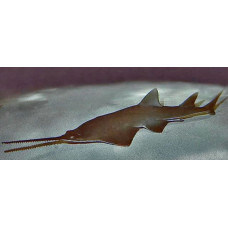Latin name
Pristis pectinata
Other name
Pristis pectinata
Identification
Smalltooth sawfish have a slightly flattened, long body. The mouth, nostrils, and gill slits are located on the ventral surface. The mouth has small teeth. Behind the small eyes are spiracles that pump water through the gills and allow the fish to lie motionless on the bottom. The skin is covered with placoid scales.
The smalltooth sawfish has an elongated flat rostrum covered on both sides with tooth-like projections. It is covered with electroreceptors that detect the slightest movement of potential prey buried on the bottom. The upper and lower jaws have 88-128 and 84-176 blunt teeth with rounded bases, arranged in 10-12 rows. The teeth are firmly and deeply anchored in hard cartilage and do not regrow if damaged. The teeth at the base are short and broad, while those at the end are long and narrow. Towards the end of the rostrum, the distance between the teeth decreases. Each tooth is slightly flattened in the dorsoventral plane. The pointed tip becomes blunt with age. There are 25 to 32 pairs of teeth on each side of the rostrum. The length of the rostrum is about 25% of the total length. It has a broad base.
Features of fish fins
The anal fin is absent. There are 2 fairly large dorsal fins of about equal size, broad pectoral fins and lower pelvic fins of triangular shape, caudal fin with a developed upper lobe.
Fish colouring
The dorsal surface of the body is brownish or gray-blue, markings are absent.
Distribution
Smalltooth sawfish were once widespread throughout the tropical and subtropical waters of the western Atlantic: from the coasts of Uruguay, the Caribbean, and the Gulf of Mexico to the coastal waters of Central America and the Atlantic coast of the United States. However, due to fishing and changing environmental conditions, they have disappeared from many of their former habitats.
Habitat
Marine freshwater and brackish bottom amphidromous species. Depth range from 10 to 88 m. Usually found in bays, lagoons, estuaries and mouths.
Size
The maximum recorded length is 7.6 m and the average length is 5.5 m.
Behavior
These fish stick to coastal and intertidal areas, but can cross deep water and reach coastal islands. It also ascends rivers and can carry fresh water.
Food and feeding habits
They feed on crustaceans, mollusks, and small fish. They use their snouts to dig for food, injure their prey, and defend themselves against sharks. Their "saw" is dotted with electroreceptors that help them locate prey in murky water.
Reproduction
They reproduce by oviparity. Fertilization is internal, the embryos develop in the womb and feed on the yolk. These rays are considered the fastest growing members of their family. Probably the greatest growth occurs in the first 2 years of life. There are 15-20 newborns in a litter. Their rostral denticles are sheathed and reach their final size relative to the rostrum only after birth. Males and females reach sexual maturity at 3.71 m and 4.15 m in length, respectively, at 7.5 and 10-12 years of age.
Fishing
They are a commercial fishery.
Relationship with a person
No danger to humans. The meat of these fish, especially the fins, which are an ingredient of the famous soup, is highly valued. The liver fat is used in folk medicine.
| Classification | |
| Phylum | Chordata |
| Class | Elasmobranchii |
| Squad | Rhinopristiformes |
| Family | Pristidae |
| Genus | Pristis |
| Species | P. pectinata |
| Features | |
| Conservation status | Critically Endangered |
| Habitat | Bottom |
| Life span, years | No information |
| Maximum body weight, kg | No information |
| Maximum length, cm | 760 |
| Sailing speed, m/s | No information |
| Threat to people | Edible |
| Way of eating | Predator |
Smalltooth sawfish
Tags: smalltooth sawfish


